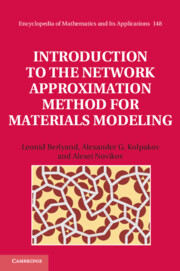Book contents
- Frontmatter
- Contents
- Preface
- 1 Review of mathematical notions used in the analysis of transport problems in densely-packed composite materials
- 2 Background and motivation for the introduction of network models
- 3 Network approximation for boundary-value problems with discontinuous coefficients and a finite number of inclusions
- 4 Numerics for percolation and polydispersity via network models
- 5 The network approximation theorem for an infinite number of bodies
- 6 Network method for nonlinear composites
- 7 Network approximation for potentials of bodies
- 8 Application of the method of complex variables
- References
- Index
2 - Background and motivation for the introduction of network models
Published online by Cambridge University Press: 05 February 2013
- Frontmatter
- Contents
- Preface
- 1 Review of mathematical notions used in the analysis of transport problems in densely-packed composite materials
- 2 Background and motivation for the introduction of network models
- 3 Network approximation for boundary-value problems with discontinuous coefficients and a finite number of inclusions
- 4 Numerics for percolation and polydispersity via network models
- 5 The network approximation theorem for an infinite number of bodies
- 6 Network method for nonlinear composites
- 7 Network approximation for potentials of bodies
- 8 Application of the method of complex variables
- References
- Index
Summary
In this chapter we review several ways of applying network models to inhomogeneous continuum media and systems of inclusions.
Discrete networks have been used as analogs of continuum problems in various areas of physics and engineering for a long time (see, e.g., Acrivos and Chang (1986); Ambegaokar et al. (1971); Bergman et al. (1990); Curtin and Scher (1990b); Koplik (1982); Newman (2003); Schwartz et al. (1984)). However, as demonstrated in Kolpakov (2006a), such analogs may or may not provide a correct approximation. In recent decades, the problem of the development of network models as rigorous approximations of continuum models was posed and solved for certain physical problems.
The objectives of our book are two-fold. First, we will develop an approach that allows us to derive network models by structural discretization (structural approximation). The key feature of this approach is that it is based on a rigorous asymptotic analysis with controlled error estimates, and thus we obtain the limits of validity for the network approximation. Secondly, we show that our network models are efficient tools in the study and prediction of properties of disordered particle-filled composites of various kinds.
Examples of real-world problems leading to discrete network models
Our interest is motivated by real-word problems and we next present three examples of highly packed composites which can be modeled by networks.
Information
- Type
- Chapter
- Information
- Publisher: Cambridge University PressPrint publication year: 2012
